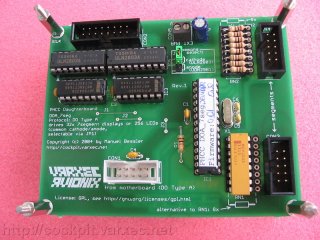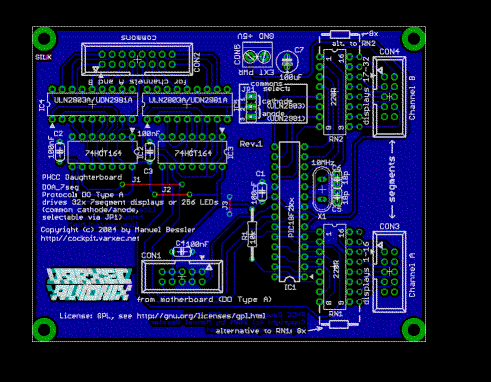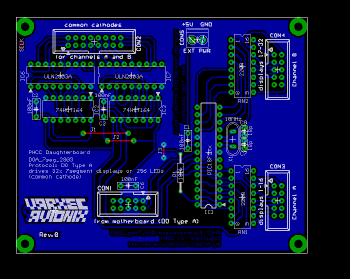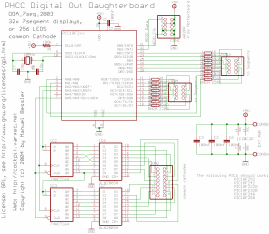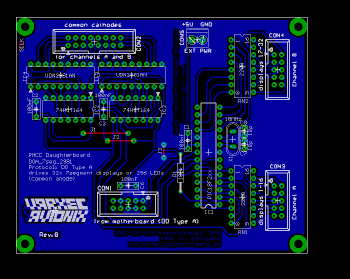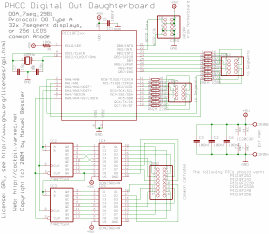Segemented displays and LEDs
Common types of segmented displays are
- 7 segment displays (many also include a decimal point, therefore they can contain 8 LEDs)
- alphanumeric (can display numbers 0-9 and letters A-Z)
- these are sometimes called 'starburst' segment displays
- number of segments depending on type, eg 16 plus decimal dot (Kingbright PSA/PSC 08)
- dot matrix, eg 5x7 dots (Kingbright TA/TC 07)
- bargraph, several different types available. (eg. Kingbright DC-10 with 10 LEDS)
Electrically, there are two types of segmented displays:
- common cathode (CC)
- common anode (CA)
When you buy displays, you'll always see either CC or CA. Most displays can be bought in both variants.
Common cathode type displays seem to be more commonly used than the common anode type. This fact is often mirrored in the prices: CC is usually a bit cheaper than CA.
PHCC can control both types. See below for boards for CC and for CA.
Seven Segment Displays are commonly used in homecockpits in various places:
- MCP/Autopilot for heading, altitude, vertical speed and airspeed/mach
- radio tuning panels
- ADF radio
- INS/IRS on some types
- fuel qty on some types
Wiring Diagram
The following graphics shows how displays are wired to the 32x DOA_7seg boards:
7 Segment Displays
DOA_7seg (Rev.1)
Jumper selectable to either
- common cathode
- common anode
Along with the Jumper selection via JP1, the suitable driver chip has to be used for IC4 and IC5.
Features
- select common cathode or anode via JP1 and IC4/IC5
- 32 displays per board or 256 LEDs or any combination
- small boardsize: 80x100mm or 1/2 Euro size.
- dimming possible
- no ghosting
- hi current displays supported (25mA max. per segment)
- all segments individually controllable
- ie. the dot
- allows you to create certain characters, like a capital 'A' or 'C', a lower case 'd',...
- individual segments fully controllable by host software
- of course, instead of 7segment displays you can also use LEDs (8 LEDs instead of one display, 16 instead of two,...)
- controlled via the PHCC DOA bus with the AP2P Protocol.
- multiple display controllers can be connected to the DOA bus...
- along with other DOA bus devices (up to 256 devices currently)
Example Setup
Schematic and Board Layout
Bill of Materials
see download page.
Eagle and Gerber files
see download page.
Older boards -deprecated- (can all be replaced by DOA_7seg Rev.1)
7 Segment Displays with Common Cathode
DOA_7seg_2803
Features
- for common cathode displays
- 32 displays per board or 256 LEDs or any combination
- small boardsize: 80x100mm or 1/2 Euro size.
- dimming possible
- no ghosting
- hi current displays supported (25mA max. per segment)
- all segments individually controllable
- ie. the dot
- allows you to create certain characters, like a capital 'A' or 'C', a lower case 'd',...
- individual segments fully controllable by host software
- of course, instead of 7segment displays you can also use LEDs (8 LEDs instead of one display, 16 instead of two,...)
- controlled via the PHCC DOA bus with the AP2P Protocol.
- multiple display controllers can be connected to the DOA bus...
- along with other DOA bus devices (up to 256 devices currently)
Schematic and Board Layout
Bill of Materials
The BOM is here: bom_doa_7seg_2803.txt
This list includes prices and links to to online catalogue pages of my primary source of electronics components, Reichelt Elektronik
7 Segment Displays with Common Anode
DOA_7seg_2981
Nearly the same as the DOA_7seg_2803. The differences are:
- for common anode displays
- different commons driver chip
- tiny differences in board layout (traces) to accomodate the different commons driver chip
Features see above section on DOA_7seg_2803
Schematic and Board Layout
Bill of Materials
The BOM is here: bom_doa_7seg_2981.txt
This list includes prices and links to online catalogue pages of my primary source of electronics components, Reichelt Elektronik
7 Segment Displays with Common Cathode
DOA_877_4067
deprecated. layouts/sourcecode available upon request. cheaper to make as the above boards, but has problems with different brightnesses of segments depending on how many segments are lit up at once (due to the cheaper approach).
Features
- for common cathode displays
- 48 displays per board or 384 LEDs or any combination
- boardsize: 80x100mm or 1/2 Euro size.
- dimming possible
- all segments individually controllable
- ie. the dot
- allows you to create certain characters, like a capital 'A' or 'C', a lower case 'd',...
- individual segments fully controllable by host software
- of course, instead of 7segment displays you can also use LEDs (8 LEDs instead of one display, 16 instead of two,...)
- controlled via the PHCC DOA bus with the AP2P Protocol.
- multiple display controllers can be connected to the DOA bus...
- along with other DOA bus devices (up to 256 devices currently)



